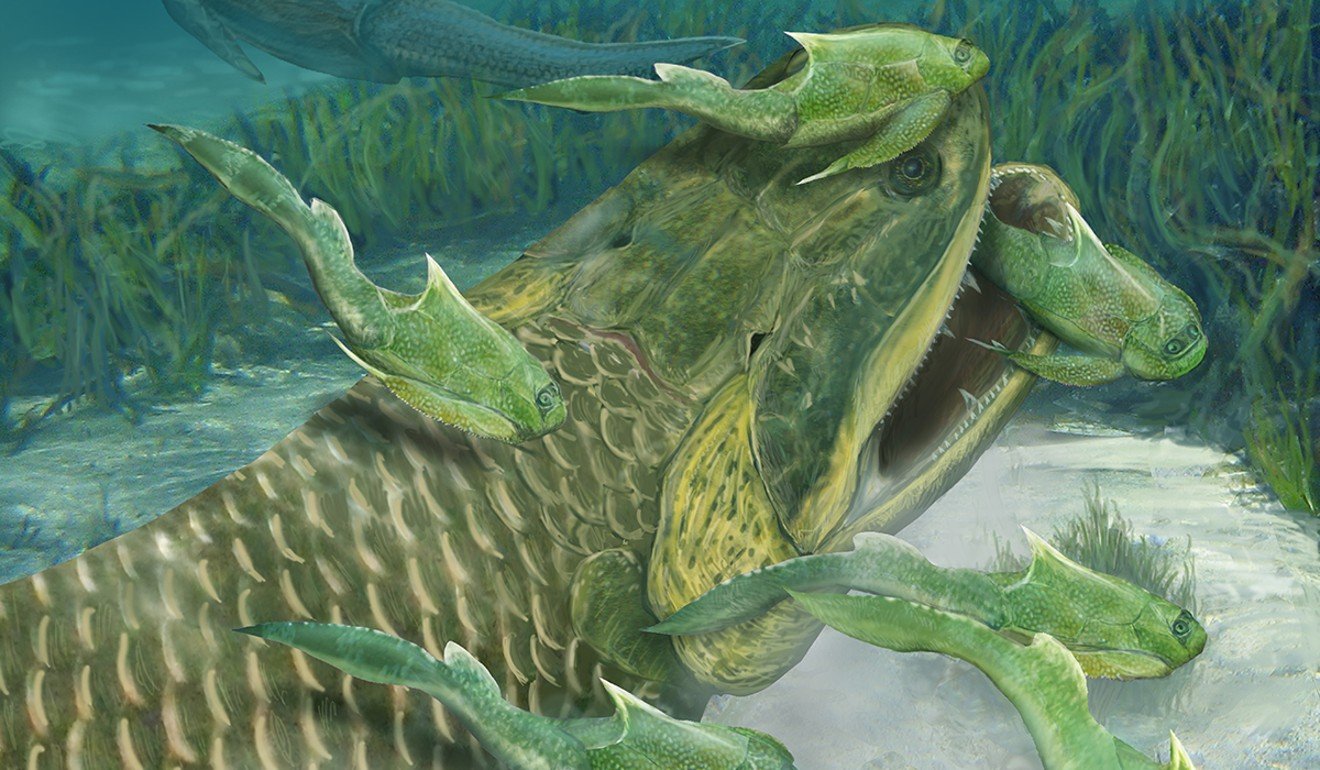
China’s monster fish fossil reignites tetrapod evolution debate
A fossil discovered in Ningxia, China rekindles a debate over whether humans are descended from a predatory fish that lurked in prehistoric rivers and lakes
A fossil discovered at a quarry in Ningxia, China has rekindled a century-old evolutionary debate: could the common ancestor of humans and other four-limbed animals be a monster fish that once lurked in prehistoric rivers and lakes?
All members of the tetrapod family, including mammals, reptiles and amphibians, can trace their origins to a group of lobe-finned fish that made the leap from water to land about 360 million years ago. But just which fish deserves our thanks for this evolutionary step remains unclear.
Rhizodonts were the largest freshwater fish known to have ever swum on the planet. Some species have been estimated at as much as seven metres long. Their powerful jaws and crocodile-like fangs were designed to “grip and drag” full-sized sharks.

These extinct predators were once considered a possible ancestor of human beings.
In the 19th century, famous paleontologists such as Richard Owen, Thomas Huxley and Louis Agassiz had heated arguments over whether the rhizodonts had climbed ashore and ventured inland. The way in which the bones of the creatures’ paired fins were arranged was similar to that of four-limbed, land-living vertebrates, or tetrapods.
The rhizodonts coexisted alongside another group of much smaller, lobe-finned fish called osteolepidida, which also started to develop tetrapod-like features.
Debate raged over which group was responsible for making the step onto land.

In recent decades, the osteolepidida argument has gained credence due to an increasing amount of fossil evidence pointing to links to primitive four-legged animals. One species, the eusthenopteron, even made it into textbooks with illustrations showing it doing push-ups in mud on muscular fins.
But a new examination of a fossil found in Qingtong valley in the Ningxia Hui autonomous region in 2002 brought the rhizodonts back into researchers’ focus.
“What we found is a rhizodont with striking similarities to tetrapod,” said Zhao Wenjin, an author of a paper on the study published early this month in the journal Nature Ecology and Evolution.
“The rhizodonts might have played a central role in the evolution from water to land. It could be our ancestor,” said Zhao, a researcher with the Institute of Vertebrate Paleontology and Paleoanthropology at the Chinese Academy of Sciences in Beijing.

The extinct fish was dated to about 370 million years ago and named by researchers as Hongyu chowi. It was about 1.5 metres long. It had many of the distinctive features of rhizodonts, such as temporal bones on the right and left sides of the face joined at the top of the head.
Meanwhile, the Hongyu’s head bones were separated from its shoulder blades, and there was a flexible neck-like component between head bones and spin. The development of these traits was an important step in early four-limbed animals evolving toward living on land.
But there was a problem, according to Zhao.
The fossil, discovered in a quarry that was producing construction materials for a motorway project, had the front-most part of its head missing. This absence led to two possible outcomes in computer analysis.

In one scenario, the rhizodonts defeated the eusthenopteron and others in the race to live on land. In the other situation the rhizodonts made the attempt to move onto land but ultimately failed.
Zhu Min, the study’s lead scientist, said there could be only one winner because all tetrapods came from a single branch of lobe-finned fish.
For more than two decades the rhizodonts theory had been left on the bench. But the new discovery returned it to centre-stage in views on the epic transition from water to land, according to Zhu.
“The chance [that the rhizodont is our ancestor] appears to be 50-50 for now,” he said.

“In the future we will carry out further examination of the Hongyu fossil with new technology and methods. We are also looking for new fossil materials. They will help shed more light on this important chapter of life evolution in which many mysteries remain,” he said.
One mystery was why the rhizodont – a giant predator – tried to get out of the water when there was no food walking on land.
Zhao said the creatures may have been living in an environment of rapid change, where lakes or swamps dried up from time to time.
“To move from one pond to another they had to walk,” he said. “The first legs were probably not developed for hunting, but migration.”

